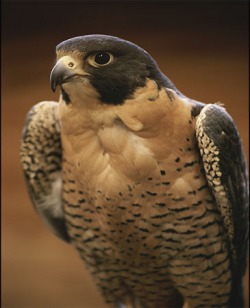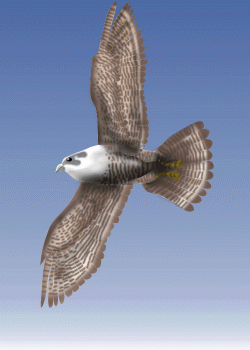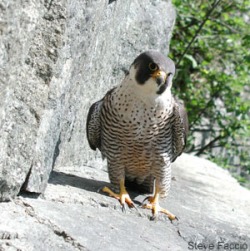Peregrine Falcon

This is a peregrine falcon.On this page I'll list facts about the peregrine falcon.
Diet: other birds
Lifespan: 7-15 years
Population:1,650
Weight: 2 pounds
Height: 15-21 in.
Clutch size: 3-4 eggs
Breeding season: May-March
Reprodution occurance: once a year
Time to hatching: up to 32 days
Where do they live?
Peregrine Falcons are found worldwide, except for rainforests and Arctic regions.
What eats them and how do they avoid being eaten?
Though Peregrine Falcons, like other birds of prey, are considered to be near the top of the food chain, they are not completely free from predators. Great Horned Owls and Golden Eagles have been known to attack them. Humans have also been known to take their eggs in hopes to raise the falcons for hunting purposes.
How do they communicate with each other?
When hunting, Peregrine Falcons will often give sharp, territorial calls in quick succession, "kee, kee kee...".
Peregrines are most vocal during courtship and mating. During this time they will make several calls: "chup, chup, chip," and "Eeee, chup, chup, chup, chup."
How do they interact with us?
Peregrine Falcons (and predatory birds in general) are a great asset to many farmers, killing millions of crop-destroying animals and insects.
Are they endangered?
Peregrine Falcons have suffered due to their dangerous position atop the food chain. Pesticides accumulate in small (not lethal) quantities in the tissues of small birds and mammals, but become concentrated enough in predatory birds, such as falcons, to kill them or render them incapable of producing offspring. Organochlorine pesticides (DDT %26 dieldrin) have been proven to reduce the birds' ability to produce eggshells with sufficient calcium content, making the egg shells thin and more likely to break. Peregrine Falcon populations dropped greatly in the middle of the 20th century, they were threatened worldwide by the increasing use of pesticides. All breeding pairs vanished in the Eastern United States. A successful captive breeding/reintroduction program, combined with restrictions in pesticide use, has been the basis of an amazing recovery by Peregrine Falcons. Now the use of many of the chemicals most harmful to these birds is restricted. It is not yet restricted in the areas of Central and South American where many subspecies spend the winter. After having been on the endangered list since 1969, the incredible recovery of Peregrine Falcons has become a perfect example of how effective human conservation can be. In the 1990's they were taken off the lists of endangered species in the United States.
Do they cause problems for us?
Birds of prey are sometimes accused of killing farm animals, such as chickens. The numbers of farm animals killed by birds of prey is of minor economic consequence when compared to their contributions to pest control.
Some more information...
Peregrine Falcons are perhaps the fastest animals on earth. In a stoop, or dive, Peregrine Falcons have been clocked at speeds of over 180 miles per hour and are believed to be able to reach up to 200 mph. Because of their fantastic agility and capability for high speeds Peregrine Falcons have been the favorite choice of falconers, who train falcons to hunt other birds.
Nickname: Duck Hawk
Want more info? Go to....
http://www.nczoo.org/animal_id/na_peregrine_falcon.cfm http://en.wikipedia.org/wiki/Peregrine_Falcon
http://www.birds.cornell.edu/AllAboutBirds/BirdGuide/Peregrine_Falcon.html


